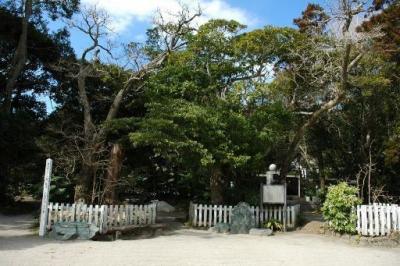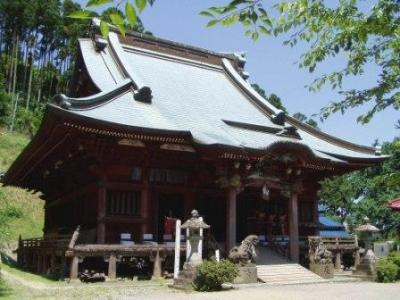本文
Shrines and Temples
Shrines in Kamogawa
Amatsu Shinmeigu (Shinmei Jinja)

The Amatsu Shinmeigu Shrine is dedicated to seven Shinto gods. The shrine (also commonly referred to as “Shinmei Jinja”) is called the Ise Shrine of the Boso region.

Also within the shrine precincts is the round leaf chisha tree, which has been designated by the prefecture as a natural monument.
Address: 2954 Amatsu, Kamogawa, Chiba
Transportation: Take the community bus (North Route) and get off at the "Shinmei Jinja-mae" stop.
Phone: 04-7094-0323
Temples in Kamogawa
Tanjoji Temple


The temple was originally built in 1276. The name “Tanjoji” literally means “birth temple,” as it was built to commemorate the birth of the Holy Priest Nichiren Shonin. Over its long history, the temple has endured earthquakes, tidal waves, and a great fire that left behind nothing but the wooden statue of Nichiren Shonin and the main temple gate. The present structure is actually the 4th generation, built by religious followers of the Nichiren Sect. Some of the highlights to see at Tanjoji Temple are the world’s largest onigawara roof end tiles, as well as the Soshido, or Founder's Hall, which houses the wooden statue of Nichiren.
Phone: 04-7095-2621
Address: 299-5501, Kamogawa, Kominato 183
Website: http://www.tanjoh-ji.jp/<外部リンク>
Seichoji Temple (Kiyosumi)

Seichoji Temple (also referred to as “Kiyosumi-dera”) is where The Holy Priest Nichiren Shonin came to study Buddhism when he was twelve. Seichoji was originally associated with the Tendai Sect in 836. In the early Edo period, the temple was converted to the Shingon Sect, and then the Nichiren Sect in 1949. After leaving to study in places such as Kamakura and Kyoto, Nichiren returned in 1253 at the age of 32 and established his own doctrine.
Seichoji is home to the Thousand Year Cedar (sennen Sugi), a Nationally Designated Natural Monument. Also, Asahigamori, which is located within the temple grounds, has been nominated as one of Japan’s Top 100 Most Beautiful Sunrise Spots.
Phone: 04-7094-0525
Address: 299-5505, Kamogawa, Kiyosumi 322-1
Website: http://www.seichoji.com/<外部リンク>
Oyamaji Temple and Fudo Hall

Located on the slope of Mount Takakura, Oyamaji Temple is said to have been built during the Nara Period. From the temple grounds, you can take in a full view of the Nagasa Plains stretching to the Pacific Ocean.
Additionally, at the entrance of Fudo Hall (Fudodo), which was later built in 1802, you can find the “Nami no Ihachi” dragon sculpture and a zushi, or a figure enshrining the god Fudo, both of which are designated as Chiba Prefecture Tangible Cultural Assets. The wooden statue of Fudo Myoo, which is presumed to be a work from the latter half of the Kamakura Period, is also a Prefecture-Designated Tangible Cultural Asset. Although the Fudo Hall is normally locked away, once a year, on February 3, it is opened to the public for viewing.
Phone: 04-7098-0178
Address: Kamogawa, Hiratsuka 1723
20 minutes by foot from Kozuka Station (30 minutes by bus via Awa-Kamogawa Station)
Website: https://oyamaji.jp/ja/<外部リンク>
Eimeiji Temple

Eimeiji Temple was built in 1279 by Kagenobu Tojo. At the time of original construction, it was located in a different place, but after being damaged in a great earthquake during Genroku Period, it was moved to its current location.
The front gate, a City Designated Cultural Asset, was built in 1812 and has a thatched gable roof. The number of remaining structures with this kind of construction is rare in Chiba Prefecture, making the temple an important resource in research to uncover more about the history of gate construction.
Phone: -
Address: 296-0043, Kamogawa, Nishicho 1146
7 minute walk from the bus stop “Kan'i Hoken Home-mae” via Awa-Kamogawa Station
Yakuoinji Temple

Specific details surrounding the founding and history of the Yakuoinji Temple remain unclear because of a lack of evidence, but it is clear that the temple was first built towards the end of the Middle Ages. Decorating the main hall’s transom is a sculpture by Nami no Ihachi
From calligraphy found inside the temple, it was revealed that the Yakuoinji Temple was built in 1648. It has been designated by the prefecture as a Tangible Cultural Asset because of its value as one of the few buildings that remain standing in the Awa region from early Edo period.
Phone: 0470-96-0090
Address: 299-2842, Kamogawa, Emi aoki 41
10 minute walk via the Saijo route bus stop “Hanabusa” from Awa-Kamogawa Station
Kyoninji Temple

The Kyoninji Temple is a highly revered temple built as a hideout for Holy Priest Nichiren Shonin. As he was being persecuted and chased down by an opposing religious group, Holy Priest Nichiren was saved by the god Kishimojin, who appeared on the branches of a cedar tree. The cedar tree still stands proudly today and has been designated by the city as a natural monument. The thatched gable roofed gate of the temple, estimated to have been made mid-Edo Period, is also a City Designated Tangible Cultural Asset.
Phone: 04-7092-0604
Address: 296-0044, Kamogawa, Hiroba 1413
10 minutes by bus from Awa-Kamogawa Station
Website: https://temple.nichiren.or.jp/1031152-kyouninji/<外部リンク>
Questions
Folk History Musium・Cultural Asserts Center
Tel: 04-7093-3800





